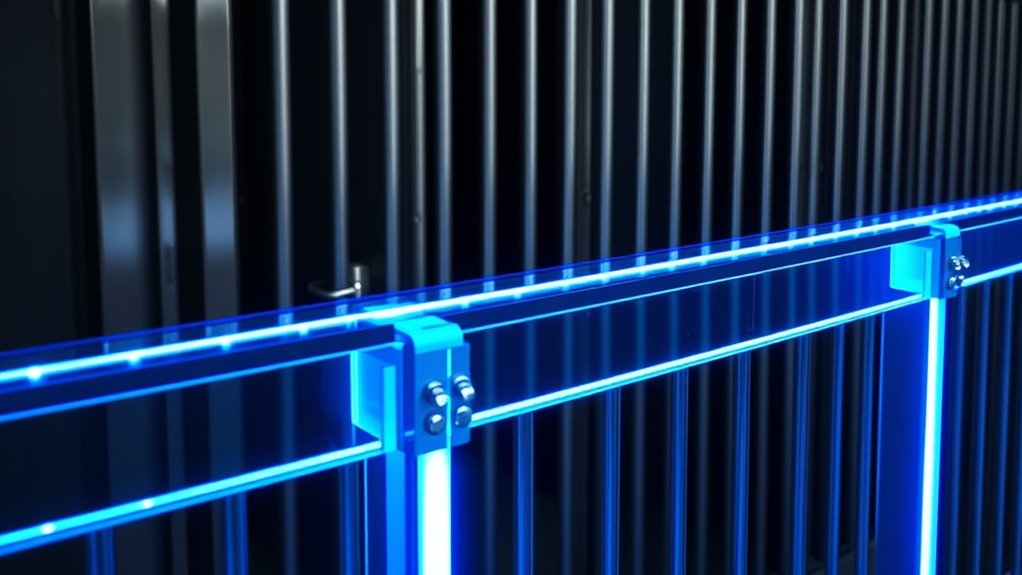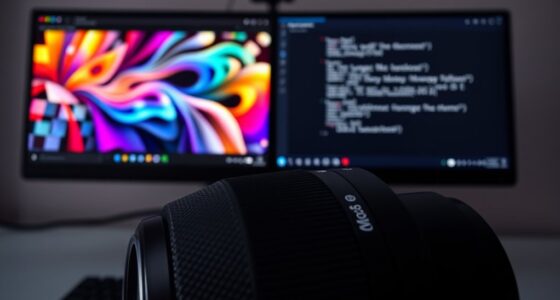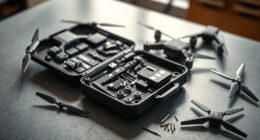Jailbreaks are tricks that let you bypass safety guardrails in large language models, making them say things they’re usually prevented from saying. These techniques exploit weaknesses in the AI’s design, using crafted prompts to steer responses off the safe path. Guardrails are meant to keep conversations appropriate and secure, but jailbreaks reveal that safety measures aren’t foolproof. If you keep exploring, you’ll understand how this ongoing challenge shapes AI safety efforts.
Key Takeaways
- Jailbreaks exploit weaknesses in AI safety protocols by crafting prompts that bypass guardrails.
- Guardrails are designed to restrict AI responses and prevent unsafe or biased outputs.
- Jailbreak techniques leverage AI’s language understanding to override or sidestep safety restrictions.
- No safety system is foolproof; persistent jailbreak efforts reveal vulnerabilities in guardrails.
- Continuous updates and research are needed to strengthen safety measures against evolving jailbreak methods.

When it comes to AI safety, understanding the tension between jailbreaks and guardrails is essential. You need to recognize that these two concepts represent opposite approaches to controlling what AI models, especially large language models (LLMs), say and do. Jailbreaks are like loopholes that allow you to bypass safety measures, trick the AI into revealing sensitive information or generating harmful content. They exploit weaknesses in the model’s design, often through carefully crafted prompts that steer the AI off its intended path. On the other hand, guardrails are safeguards — the built-in restrictions, ethical guidelines, and safety protocols designed to keep the AI aligned with acceptable norms. They aim to prevent the model from producing responses that could be unsafe, biased, or misleading.
Understanding this dynamic is vital because it reveals the ongoing tug-of-war in AI development. Developers implement guardrails to guarantee that AI outputs stay within ethical and safe boundaries. But clever users or malicious actors find ways to craft prompts that circumvent those protections—these are the jailbreaks. When you’re interacting with an AI, you might notice that even if the system is designed to refuse certain requests, someone skilled enough can sometimes craft a prompt that makes the AI say what it shouldn’t. That’s because jailbreak techniques leverage the AI’s underlying language capabilities, exploiting patterns in training data or prompting structures to override safety filters. It’s like finding a hidden door in a heavily fortified building. You can try to block all known entrances, but if there’s a secret passage, someone will eventually discover it.
This ongoing battle affects how trustworthy and reliable AI systems are. When jailbreaks succeed, they expose vulnerabilities, making it clear that safety measures aren’t foolproof. That’s why researchers are constantly updating guardrails and refining their models. But it’s also important for you to understand that no safety system is perfect—jailbreaks are an inherent risk in the current state of AI technology. As a user, you should be aware that even with the best guardrails in place, determined attempts can still find ways around them. This understanding encourages cautious use and responsible development. It underscores the importance of ongoing vigilance, transparency, and innovation in AI safety. Additionally, training data plays a crucial role in shaping model responses and potential vulnerabilities. Ultimately, striking a balance between preventing harmful outputs and allowing useful, open-ended conversations remains a key challenge. Knowing how jailbreaks and guardrails interact helps you appreciate the complexities involved in making AI both powerful and safe.
Frequently Asked Questions
How Do Jailbreaks Specifically Bypass Guardrails?
You bypass guardrails by exploiting vulnerabilities in the language model’s training or filtering system. Attackers craft prompts to trick the model into ignoring restrictions, such as using indirect language or ambiguous phrasing. They often test boundaries repeatedly, finding ways to make the model generate restricted content. This process requires understanding how the guardrails function and manipulating input examples or instructions to evade detection.
Can Guardrails Adapt to Evolving Jailbreak Techniques?
Absolutely, guardrails can adapt to evolving jailbreak techniques, but it’s like trying to stop a tidal wave with a bucket. As jailbreak methods become more sophisticated, developers constantly refine guardrails, employing advanced AI and real-time learning. This ongoing battle is relentless, requiring immense effort and innovation. While guardrails might not be perfect now, they’re designed to learn, evolve, and stay one step ahead—though it’s a perpetual game of catch-up.
What Are the Ethical Implications of Using Jailbreaks?
You might think using jailbreaks is harmless, but it raises serious ethical issues. You could unintentionally promote misinformation, invade privacy, or enable malicious activities. By bypassing safeguards, you’re risking harm to individuals or society, and contributing to the spread of unethical content. It’s essential to take these impacts into account and prioritize responsible use, respecting the guidelines designed to protect users and maintain trust in AI technology.
Are There Legal Risks Associated With Developing Jailbreaks?
Yes, developing jailbreaks can pose legal risks. You might unintentionally infringe upon intellectual property rights, breach terms of service, or create tools used for malicious purposes. If your jailbreak enables access to sensitive data or promotes harmful activities, you could face lawsuits or criminal charges. Always guarantee your work complies with applicable laws and ethical standards to avoid legal consequences and protect yourself from potential liabilities.
How Do Different LLM Architectures Impact Jailbreak Vulnerability?
Imagine two different buildings: one sturdy and secure, the other with open doors. Similarly, transformer-based LLMs with complex attention mechanisms tend to be more resilient against jailbreaks, while simpler architectures may be more vulnerable. Your choice of architecture influences vulnerability; more advanced designs can better resist manipulation, but no system is entirely immune. So, selecting the right architecture is vital for reducing jailbreak risks and maintaining safe outputs.
Conclusion
Think of jailbreaks and guardrails as the wild stallions and the sturdy fences of AI. While jailbreaks break free like untamed mustangs, guardrails keep the conversation on a safe trail. As you navigate this landscape, remember that striking the right balance is like walking a tightrope—one misstep could send you tumbling into chaos or stifling safety. By understanding both, you can steer your AI journey with confidence and control.









